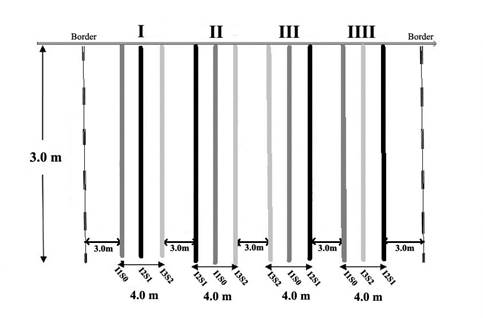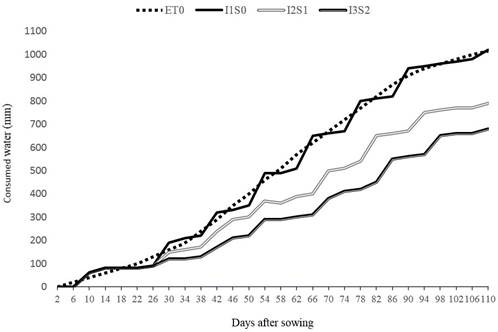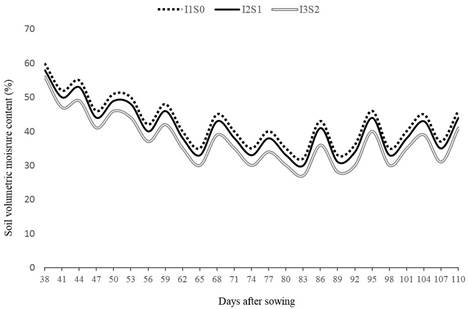Introduction
Water deficit is known as the most important limiting factor in agricultural products especially in the arid and semi-arid regions. Agriculture has been negatively influenced by low obtainable water because of climate change, making water stress conditions for crucial economic plants like legumes (Khodadadi-Dehkordi, 2016). As Iran is the major region consisting of the arid and semi-arid areas with limited water resources, in case the minimum plant water use is not maintained, the plant would experience drought stress and the products would suffer irreparable losses (Lafitte, 2002). Iran is extremely exposed to the negative influences of climate change. One way for optimal use of the water resources and their preservation is the use of superabsorbent polymers (SAPs) which not only provide conditions for improved products quality but also results in increased water consumption efficiency in the arid and semi-arid areas (Fazeli-Rostampour, Theghat-al-Islami, & Mousavi, 2011). SAPs could absorb and store water up to several times of their own weight. Due to the drying up of the environment, the water retained in the superabsorbent is gradually discharged and thus the soil would remain moist for a long time without needing further irrigation. This property has great importance in confronting water shortage and reducing the harmful effects of drought stress in plantations (Haghighi, Mozafarian, & Afifi-Pour, 2014; Wu, Liu, & Liang, 2008). Superabsorbent polymers cause water retention in the soil and reduce the number of irrigation frequency up to 50% (Nazarli, Zardashti, Darvishzadeh, & Najafi, 2010). The scientific name for cowpea is Vigna unguiculata L. which belongs to the Fabaceae plant family. It is an annual plant in the family of beans which in addition to its effect on the soil fertility, its remains could be well stored in silos. It is also a good source of protein. Cowpea is a valuable plant rich in protein, carbohydrate, fat, minerals and vitamins. It could be used both for human and animals consumption it is also used in the Pharmaceutical Industry (Shukla & Dixit, 1996). This plant is one of the most popular productions in Khuzestan province, Iran and cultivated by farmers mostly. Amiri-Deh-Ahmadi, Parsa, Nezami and Ganjeali (2010), in a research concluded that the water stress at the flowering stage of the chickpea plant reduced the grain yield (GY), relative growth rate, plant growth rate, pure photosynthesis rate and increased the leaf area. Allahyari, Golchin and Vaezi (2013) reported that the superabsorbent polymers had a significant effect on the increase of the biologic yield, number of pods in chickpea plant and the 100 grains weight concerning the control treatment. Rajabi, Sajedi and Roshandel (2012) reported that the effects of Salicylic Acid and superabsorbent and their reciprocal effects on the number of pods in the plant, the 1 000 grains weight, the GY and the biologic yield of the chickpea plant are significant. Abhari, Azizi and Hareth-Abadi (2017) through investigating the effect of superabsorbent on the yield and the yield components of the chickpea plant in the drought stress conditions, reported that the use of superabsorbent to achieve a desirable economic performance is the best possible way. Timouri, Shiroui and Mohamadi-Babazeidi (2013) through investigating the effects of drought stress and the superabsorbent on the physiologic properties of the dry bean plant reported that the drought stress and superabsorbent both influenced the bean physiologic properties. So that they reported the highest rates of leaf area and the relative water content values belonged to the application of superabsorbent. Also, the use of superabsorbent polymers caused increased biologic yield, number of pods in plant and the 100 grains weight with respect to the control treatment. Abbaslou, Kazemeini, Edalat and Dadkhodai (2014) reported that drought stress had a significant effect on the reduction of leaf area index (LAI), photosynthesis rate, stomatal conduction and total chlorophyll of a chickpea plant. In arid and semi-arid regions, usually identified by increased evapotranspiration rate, extensive soil salinity and restricted water supply, water use efficiency (WUE) needs to be increased (Lo Bianco, Talluto, & Farina, 2012). This condition needs that the more accurate control levels of irrigation water (IW) be examined which could store more water without losing productions (Ro, 2001). Therefore, it is crucial to apply deficit irrigation (DI) for achieving a better ratio of IW amount to optimum yield. In previous studies the irrigation method was based on surface irrigation; however, few have assessed the effects of superabsorbent polymer and DI in drip irrigation system. The objective of this study was to evaluate the superabsorbent polymer effect on WUE and grain yield of Vigna unguiculata L. under drought stress conditions.
Materials and methods
Experimental details
The experimental farm was conducted (31°48′30′′N and 48°46′15′′E, and elevation of 11 m) in Hamidiyeh, Khuzestan province, Iran. Hamidiyeh has a hot and relatively arid climate and has a hot summer and a Mediterranean winter. The average annual precipitation is about 210 ml and the average temperature is about 5 Celsius degrees in the winter and over 50 Celsius degrees in the summer. Table 1 shows the chemical properties of the IW and Table 2 shows the physical and chemical properties of the tested soil.
Table 1 The chemical properties of the IW.
| EC (dS.m-1) | Na (meq.l-1) | Ca (meq.l-1) | Mg (meq.l-1) | SAR |
|---|---|---|---|---|
| 1.1 | 5.5 | 4.4 | 2.5 | 2.96 |
Table 2 The physical and chemical properties of the soil.
| Soluble potassium (mg.kg-1) | Soluble phosphorus (mg.kg-1) | Bulk density (g.cm-3) | EC (dS.m-1) | Soil texture | Size of the soil particles (%) | ||
|---|---|---|---|---|---|---|---|
| Sand | Silt | Clay | |||||
| 353 | 50.6 | 1.59 | 6.85 | Loam | 34 | 44 | 22 |
Besides, for 0-60 cm of soil layer, pH, total nitrogen and soil organic matter were 7.4, 3.3 and 45.7 g/kg, respectively. The cowpea cultivar used in this study was named Kamran. The growing of this cultivar, characterized by a hot and dry climate, is just related to irrigation. Because the value of precipitation is not enough to provide the necessity of water supply for irrigation. The grains were hand sown on the rows with 3 m long and 2 m apart on June 22, 2017-2018 (two growing seasons). Before sowing, a drip irrigation system was located at each row with 25 cm drippers apart. The value of water used in every irrigation event has been recorded by a flow meter. The amount of 30 mm for IW was given after sowing and after the appearance of crops, they were thinned to stable one plant every 25 cm in the rows (12 crops for row) and, in front of each dripper an individual cowpea crop was located. After the appearance of plants, for optimizing IW usage and decrease the water use, Super-AB-A-300 polymer (Table 3) was combined with the soil at a depth of 20 cm near the crop. This polymer is a granular type and produced by Rahab Resin Co. with product license holding of Iran Polymer and Petrochemical Institute (Rahab Resin Co., 2016). This hydrophilic polymer is a tripolymer of acrylamide, acrylic acid and acrylate potassium.
Table 3 The properties of Super-AB-A-300 polymer.
| properties | Super-AB-A-300 polymer |
|---|---|
| Shape | granular |
| Density | 1.4-1.5 (gr.cm-3) |
| Size of particles | 30-100 (µm) |
| Maximum stability in soil | 5 (year) |
| Practical capacity of water uptake | 600 (g.g-1) |
The experimental plan was conducted as a randomized complete block design with four replicates (Figure 1).

Figure 1 Layout of the plan (without scale). I1S0, I2S1 and I3S2 present cowpea rows with 0.0, 7.0 and 14.0 grams of Super-AB-A-300 polymer in the soil and with IW treatments related to 100%, 75% and 55% ETc demand, respectively.
For approving the efficacy of superabsorbent polymer, only a few irrigation treatments with different levels of Super-AB-A-300 polymer were considered: treatment I1S0, including 100% ETc demand as irrigation amount and with 0.0 g SAP (I1:100% - S0:0.0 g SAP); Treatment I2S1, including 75% ETc demand as irrigation amount and with 7.0 g Super-AB-A-300 polymer for plant (I2:75% - S1:7 g SAP); Treatment I3S2, including 55% ETc demand as irrigation amount and with 14.0 g Super-AB-A-300 polymer for plant (I3:55% - S2:14 g SAP).
Assessments
The mean daily reference crop evapotranspiration (ET 0) was estimated using Penman-Monteith method (Allen, 1998) and the meteorological data obtained by the Ahvaz weather station that was near the farm. For determination of the crop evapotranspiration (ETc) or crop water requirement were used ET 0 multiplied a crop coefficient (Kc) (Allen, 1998). The applied irrigation water (AIW) in each irrigation during the vegetative stage to provide 100% ETc demand was calculated using the following equation (Satriani, Catalano, & Scalcione, 2018; Allen, 1998):
where:
AIW: Applied irrigation water (mm).
Ea: Application efficiency (%), considered by 90% for drip irrigation.
ETc: Crop evapotranspiration (mm day−1).
SWD: Soil water deficiency on one day ago (mm day−1).
The soil water content (SWC) was monitored using the multiplexing TDR system (HandiTrase Soilmoisture Meter w/FCT Probe, model 6085K3, USA). TDR system was remotely regulated by a computer. In the center of the blocks rows, twelve 40 cm-long TDR waveguides were fixed vertically in the 5-45 cm depths of the soil surface. The soil surface layer is open to soil water (SW) variations, therefore, the TDR waveguides were fixed after the first 5 cm of soil especially due to perfect insulation (Satriani et al., 2018). For measuring the GY of cowpea plant, the pods of 12 crops were removed from each rows during harvest and after abandoning the crops to dry in farm which occurred on October 13, 2017-2018. Irrigation WUE was determined as GY divided by applied IW all along the entire growing season. For determining the agricultural water productivity (AWP), GY was divided by the entire water consumption (IW plus precipitations) (Abhari et al., 2017; Molden et al., 2010). The results presented in the figures and tables were the mean values of the two growing seasons.
Results and discussion
Variations of soil moisture and ET 0 under varied water and superabsorbent treatments
Readily available water (RAW) for cowpea plant that was cultivated on loam soil and with the highest root depth of almost 80 cm was 51.48 mm before moisture stress (Allen, 1998). Thus, due to this amount, the cowpea plant was irrigated when the SWD became higher or equal to the readily available water. The initial SW was supposed to be at field capacity (FC), because an extensive irrigation occurred directly after sowing (IW depth was by 30 mm equal to 300 m3/ha). This conveyed that soil water deficiency was 0.0 at the start of the growing cycle and this presumption was approved by SW assessment. According to Eq. (1), the total value of AIW was 1015 mm (related to 100% ETc demand), 761.25 mm (related to 75% ETc demand), 558.25 mm (related to 55% ETc demand), for I1S0, I2S1 and I3S2 treatments, respectively. Table 4 shows monthly time series of rainfall, temperatures and IW amount for the Kamran cultivar.
Table 4 Daily mean estimated ET 0, precipitation, daily mean temperature and IW amount for cowpea plant.
| Month | Precipitation (mm) | The mean of daily temperature (°C) | The mean of daily estimated ET 0 (mm day -1 ) | Irrigation 100% of ETc demand (mm) | ||
|---|---|---|---|---|---|---|
| Min. | Max. | Average | ||||
| July | 0 | 27.9 | 50.9 | 40.3 | 11.0 | 273 |
| August | 0 | 27.9 | 49.4 | 39.1 | 10.7 | 325 |
| September | 0 | 22.1 | 47.6 | 34.8 | 9.7 | 327 |
| October | 0 | 14.4 | 42.9 | 28.2 | 7.1 | 90 |
Figure 2 indicates the cumulative ET 0 and cumulative IW consumed for cowpea plant in the whole treatments. All along the vegetative stage and particularly after appearance, daily ETc rose significantly up to nearly 80 days after sowing.

Figure 2 Cumulative ET 0 and cumulative IW consumed for cowpea plant in the whole treatments all along the vegetative stage.
Soil water content is straight dependent on the ET procedure and the trends of SWC related to the whole treatments are indicated in Figure 3. Allen (1998) showed that the optimum conditions of SW are the actual field situations in well-administered fields. In this experiment, despite the water supply was lower, the SW was not significantly decreased in the treatments under DI. In correspondence with the reports of Abhari et al. (2017); Dabhi, Bhatt and Pandit (2013); Parvathy, Jyothi, John and Sreekumar (2014); Satriani et al. (2018) and Khodadadi-Dehkordi (2016), the same trend could be because of the fact that the superabsorbent polymers take up water and then gradually release it back to the soil to balance the lower water reservoir. Other studies have verified that the superabsorbent polymer application in water deficit situations has reduced the adverse influence of DI (Satriani et al., 2018; Islam et al., 2011; Khodadadi-Dehkordi, 2016; Sayyari & Ghanbari, 2012). Besides, Khodadadi-Dehkordi (2016) and Fallahi, Taherpour-Kalantari, Aghhavani-Shajari and Soltanzadeh (2015) reported that the application of superabsorbent polymer could increase the plants irrigation intervals.

Figure 3 Soil volumetric water content in cowpea rows with varied superabsorbent polymer and water values.
Also, Wang and Wang (2010) and Khodadadi-Dehkordi (2016) have shown that water evaporation rate was decreased in sandy soil with adding superabsorbent polymer compared to the soil without SAP. Khodadadi-Dehkordi (2016); Dorraji, Golchin and Ahmadi (2010) and Akhter et al. (2004) reported the similar effects of superabsorbent polymer on the water-holding properties of loamy and sandy soils.
Cowpea GY
The cowpea plants should be irrigated all along the growing season and was considered reasonable for investigating the influence of superabsorbent polymer and IW on GY. According to the results, the highest amount of GY was achieved when the plant was irrigated with the value of IW by 100 and 75% of ETc demand, while lower amount was achieved when the plant was irrigated with the value of IW by 55% of ETc demand. Besides, the soil treated with superabsorbent polymer, in mild DI treatment (I2S1), made it possible to obtain the same GY as the complete irrigation treatment (I1S0) and there was no significant difference between them. This could related to the fact that superabsorbent polymer is able to retain water and nutrients and release them in water stress situations, rebuilding the optimum conditions of SW appropriate for crop growth. This result is confirmed by Khodadadi-Dehkordi (2016); Abhari et al. (2017) and Satriani et al. (2018). Figure 4 indicates a significant second-degree polynomial relation between cowpea GY and seasonal IW applied.
This relation is curvilinear and indicates that cowpea GY rising with the IW amount, and when a particular level is achieved, it does not increase anymore. A research by Khodadadi-Dehkordi (2015, 2016) approved these consequences. He investigated the application of superabsorbent polymer on corn yield under DI conditions and reported that by enhancing the intensity of drought stress, corn GY decreased, however, there was no significant variation between 100 and 75% of ETc demand treatments for the corn crop, with 0.0 and 45.0 g.m-2 of superabsorbent polymer respectively. On the contrary, the minimum GY was achieved in the treatments with 50% of ETc demand for the crops. The results showed in Table 5 indicate that the maximum amounts of IWUE and AWP with significant varied averages (P < 0.05) were achieved in I2S1 and I3S2 treatments compared to control (I1S0 treatment).
Table 5 Cowpea GY, irrigation and precipitation values, WUE and AWP data kg/ha mm. Varied letters within each column show significant variation between treatments at P < 0.05.
| Irrigation and superabsorbent polymer treatments | Cowpea GY (kg. ha-1) | Irrigation + precipitation (mm) | WUE | AWP |
|---|---|---|---|---|
| I1S0 | 3210a | 1015+0 | 3.16c | 3.16c |
| I2S1 | 3150a | 761.25+0 | 4.14b | 4.14b |
| I3S2 | 2860b | 558.25+0 | 5.12a | 5.12a |
Khodadadi-Dehkordi (2016), and Zhang, Chen, Sun, Pei and Wang (2008) reported that IWUE was conversely related to the total IW requirement all along the growing cycle, and for higher IWUE, the water would be decreased under the IW demand for the maximum GY. Thus, the mix of mild DI and superabsorbent polymer (I2S1), that leads to increase the AWP, was an acceptable policy to optimize cowpea GY and water utilization. These achieved consequences were approved by the researches on maize, sorghum, cotton, peanut, bean, chickpea (Khodadadi-Dehkordi, 2015; Khodadadi-Dehkordi, 2016; Abhari et al., 2017; Hazrati et al., 2017; Timouri et al., 2013; Mazen, Radwan, & Ahmed, 2015; Najafinezhad, Tahmasebi-Sarvestani, Modarres-Sanavy, & Naghavi, 2014; Satriani et al., 2018).
Conclusions
The findings in this study indicated that using superabsorbent polymer for retaining IW conserved the GY and at the same time decreased the IW value. The applying Super-AB-A300 polymer for cowpea plant in drought stress conditions conserved a suitable SW capability. The maximum amounts of cowpea GY under varied levels of superabsorbent polymer and IW values were achieved when the cowpea plant was irrigated with the IW value by 100 and 75% of ETc demand, but the mix of DI and superabsorbent polymer leads to the highest AWP. Thus, the use of Super-AB-A300 polymer in the irrigated plants should be promoted, also based on the achieved consequences and as shown in the text, approved by other researches on varied plants. This study has a strong interest for the hot and dry regions where the aridity situations in the summer season permit planning the test for investigating the effect of the SAP on varied cultivations in the experimental farms. It is suggested that the new experiments for evaluating the optimum value of applied superabsorbent polymer in the soil, the SAP type and its levels depends on the factors like the plant and soil type are needed.











 texto en
texto en 




